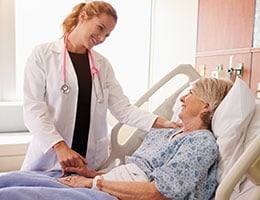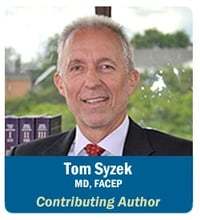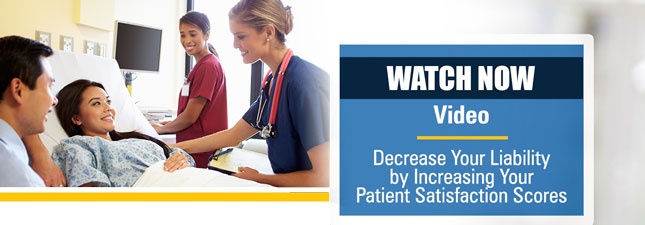 Whether we like it or not, the future of medicine is geriatrics. As the demographics in the United States change in the next 50 years, it is predicted that practitioners will find themselves providing care to a much larger group of elderly patients. For example, the 2014 census data showed that 14.5% of the U.S. population was 65 years of age or older. By 2040, it is estimated that this age group will grow to comprise 22% of the population. People are actually living long enough to form a subgroup of elderly patients who are over 85 years old – the “super-elderly.” This crowd of the super elderly grew three to four times faster than the general population between 1990 and 2010.
Whether we like it or not, the future of medicine is geriatrics. As the demographics in the United States change in the next 50 years, it is predicted that practitioners will find themselves providing care to a much larger group of elderly patients. For example, the 2014 census data showed that 14.5% of the U.S. population was 65 years of age or older. By 2040, it is estimated that this age group will grow to comprise 22% of the population. People are actually living long enough to form a subgroup of elderly patients who are over 85 years old – the “super-elderly.” This crowd of the super elderly grew three to four times faster than the general population between 1990 and 2010.
What does this mean for healthcare providers in general and specifically for emergency practitioners? Healthcare will evolve to require more time, resources, space and money to care for the elderly. Just as we have designed and built space in EDs and hospitals to provide care to pediatric patients, it has become necessary to incorporate the special needs of the elderly into the care environments of the future.
The environment of care, particularly in hospitals, is often poorly suited to care for elderly patients for the following reasons:
- Little privacy
- High volume, high stress
- Unpleasant surroundings
- Anxious, worried patients
- Limited provider time
- Noisy, which is difficult for elderly with hearing deficits
The Bias of Ageism
Our society values youth, and old age is looked upon with fear and negativity. Much of this attitude comes from stereotyping the elderly. For providers to be successful in caring for the elderly, they must develop and maintain positive attitudes. Negative views of aging, known as ageism, must be avoided.
Some observations:
- Since elderly patients often live in nursing homes and are frail and disabled, our view of the elderly is skewed.
- The language of ageism reflects our negative views. Take your pick: Bag, Bat, Biddy, Codger, Coot, Crone, Old Fart, Fogy, Fossil, Fuddy-duddy, Geezer, Goat, Gomer, Granny, Grumpy, Hag, Miser, Rickety, Senile, Spinster, Toothless, Withered, Wrinkled.
- Misperceptions can adversely affect treatment. For example, falls, incontinence and confusion are not normal deteriorations with age and should be aggressively evaluated.
- The majority of older people are productive, active, heterogeneous and independent.
- Aging should be regarded as another stage of life with its own joys, pains and experiences.
Older Age = More Healthcare
 However, as providers we must recognize that the elderly require care resources in greater proportion than their numbers represent in the population. For example, elderly patients presenting to an emergency department are:
However, as providers we must recognize that the elderly require care resources in greater proportion than their numbers represent in the population. For example, elderly patients presenting to an emergency department are:
- More likely to be admitted than younger patients; 36% of ED visits require admission
- More likely to need ICU admission; 7% require intensive care admission
- More likely to use EMS services; 38% use ambulances for ED visits
This first step in the successful approach to caring for elderly patients is to acknowledge that the elderly population is growing rapidly and that geriatric patients require more time, resources and energy than younger patients.
The second step is to realize that similarly to neonates and infants, the older patient often presents with subtle, atypical symptoms of a serious condition. A cavalier attitude toward geriatric patients will make you a defendant.
10 Principles of Geriatric Care in Acute Settings
Failure to provide adequate care to special patient groups can result in diagnostic error, bad outcomes and malpractice litigation; some examples are trauma, pregnancy and pediatrics. Another patient category that calls for special care is geriatrics. The following are 10 principles, illustrated by examples, that are key to the successful and defensible care of the elderly and super-elderly, particularly in acute care environments.
- The patient’s presentation is frequently complex.
- Example: The elderly patient with vague complaints such as the “WADAO” and “TADAO” sisters. One is “Weak and Dizzy All Over,” and her sister is “Tired and Dizzy All Over.”
- Although these complaints may herald serious, life-threatening diseases, they are a source of frustration for many practitioners. Get used to it.
- Common diseases present atypically in this age group.
- A classic example is an MI presenting with NO chest pain, but with dyspnea or weakness.
- Faced with either of these complaints, the prudent provider will consider cardiac causes.
- Co-morbid diseases may confound the presentation.
- Consider hypertension, diabetes, and auto-immune and cardiac diseases.
- Chief complaints such as syncope, altered mental status, and fever may be caused or influenced by these conditions.
- Polypharmacy is common and may be a factor in the presentation, diagnosis and management.
- The one- or two-page med list speaks for itself. Accept the fact it will drive you crazy.
- The elderly are twice as likely as younger patients to suffer adverse medication effects.
- Up to 5% of hospital admissions for the elderly are caused by adverse drug effects.
- Drug actions, including metabolism and clearance, are altered due to physiologic changes of aging.
- Recognition of possible cognitive impairment is important.
- 30% to 40% of elderly ED patients will have cognitive impairment.
- Failure to recognize this may result in inadequate workup and improper disposition.
- Mental status assessment, however brief, should be a routine part of the examination of geriatric patients.
- Some diagnostic tests may have different normal values.
- Familiarity with the list of unchanged and commonly abnormal laboratory values in the elderly (see below) can prevent costly mistakes due to false assumptions.
- The likelihood of decreased functional reserve must be anticipated.
- Cardiac output and reserve decline with age.
- The immune system may become sluggish in response to infection.
- Special senses of touch, sight, hearing, taste and smell can be diminished by aging.
- Social support systems may not be adequate, and patients may need to rely on caregivers.
- Discharging someone to a poor home environment is a sure way to guarantee a bounceback to your office, urgent care, ED or hospital.
- Asking how your about-to-be-discharged patient will eat, dress, bathe, walk and make follow-up visits may influence your disposition decision.
- A knowledge of baseline functional status is essential for evaluating new complaints.
- Information obtained from the patient, family, primary care physician and old records can be used to establish this baseline.
- Making the assumption that a patient with confusion, aphasia, weakness or acute delirium has always been that way can lead to missed diagnoses and unwise disposition.
- Health problems must be evaluated for associated psychosocial adjustment.
- The highest rate of successful suicide is in elderly men.
- Be on the lookout for depression, anxiety, alcohol and substance abuse even in the geriatric population.
Laboratory Assessment of the Elderly
- These laboratory parameters are generally unchanged by aging. Abnormal values should prompt further evaluation:
- Hemoglobin and hematocrit
- White blood cell and platelet count
- Electrolytes
- BUN
- Liver function tests
- Calcium and phosphorus
- Common abnormal laboratory values in the elderly due to normal aging and other age-related changes:
- Sedimentation rate
- Glucose
- Creatinine
- Albumin
- Alkaline phosphatase
- Serum iron & TIBC
- Urinalysis
Things Are Not Always as They Seem
I will leave you with this list of 6 chief complaints that should prompt a high index of suspicion for an underlying serious cause in an older patient:
- Fall = syncope until proven otherwise
- Nausea = myocardial ischemia until proven otherwise
- Abdominal pain = acute abdomen until proven otherwise
- Warfarin or NOAC + injury = intracranial hemorrhage until proven otherwise
- Confusion = sepsis until proven otherwise
- WADAO (weak and dizzy all over) = all the above until proven otherwise!
Our elderly patients will require more time given the usually complicated nature of their histories, medications and co-morbidities, which also means they require more testing. Not all patients need ETKTM (every test known to man). However, it is important for healthcare providers to recognize that our older patients do not always follow what’s in the textbooks; providers must be vigilant to ensure that they don’t underestimate the potential perils of caring for the booming population of older individuals.


